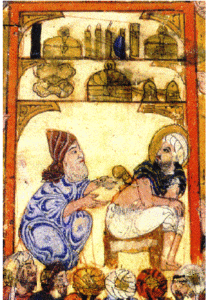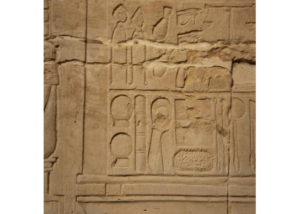While investigating data for our history project on the development of the profession of physiotherapy in the United Arab Emirates, I was reminded of the practice of cupping (hijamat) and have noted its continuing access as a physical therapy in this part of the world.
Every year the Dubai Health Authority reports on the activity of private clinics. In 2018, it was reported that 503,490 persons accessed private physiotherapy services (Government of Dubai, 2018). Of these 15.2 % were nationals of the UAE and the remainder, expatriates. Most accessed physiotherapy services reported as kinesiotherapy and secondary to that electrotherapy. Although cupping is offered in physiotherapy clinics it was not reported separately. Alternative medicine clinic activity is also reported and a small percentage (2%) of persons were treated with cupping (hijamat). However, this ancient therapy is increasingly being offered by private physiotherapy clinics. Hijamat has been part of the physical therapies offered by multiple practitioners for centuries in the Middle East, Greece and China and is mentioned in historical texts such as Maimonides (1138-1205) book on health.

Glass cups being removed.
I remember seeing the marks of cupping on the paraspinal area of a young girl with cerebral palsy when I worked as a physiotherapist in Dubai in the late 90’s. Her parents told me that the child’s grandmother had recommended this therapy to try and support better mobility. It made me wonder about the history of this therapy and its resurgence in the private physiotherapy clinics of the UAE. Certainly, as a placebo, cupping was an accessible physical treatment in historical times, offering counterirritation and pain relief. Reading further about this treatment I have had to wonder about the relationship of hijamat to the practice of acupuncture and interferential therapy in physiotherapy practice. There are certainly some similarities related to the theoretical underpinning of these therapies and some research investigation comparisons of these treatments in low back pain and plantar fasciitis (E-Rahmin, 2020, Ge et al, 2017).
The practice of hijamat consists of drawing tissue into a glass or plastic (traditionally metal) cup placed on the targeted area by creating a partial vacuum, either by heating or subsequent cooling of the air in the cup or by using a mechanical pump. The cup is usually left in place between 5 and 15 minutes.
Al Rawi and Fetters (2019) wrote about the therapy offered at the time of the famous Middle Eastern physician, Ibn Sina (Avicenna) and named this Traditional Arabic and Islamic Medicine (TAIM). Since the third millennium BC, Arab and Islamic practitioners have drawn on traditional practices with roots in the Graeco-Roman, Chinese, Persian and Ayurvedic theories and principles. Practitioners believed in the promotion of health, prevention of disease and the restoration of health through regimental and dietary therapies. Arab and Muslim physicians such as Ibn Sina (Avicenna) believed both physical and spiritual health is essential, that the body should be treated as a whole entity rather than separate parts and organs, and that the body possesses the natural ability to heal when provided with rest, a good diet, fresh air, and cleanliness (Saffari & Pakpour, 2012).


Ancient depictions of cupping-Persia and Egypt.
In the TAIM framework devised by Al Rawi and Fetters (2019), hijamat (cupping) is considered as a primary method along with manual therapy, hydrotherapy and physical movement among others. These primary methods describe therapies which when used individually can impact the vital force of the body in order to preserve or restore health and achieve the goals of recovery. It is proposed that by virtue of their effect, procedures listed under primary methods are able to balance the elements inherent in every individual by manipulating innate or acquired, physical or energetic, deficiencies involving body, mind, and spirit.
The earliest recorded references to cupping therapy are found in the Ebers Papyrus, dating back to 1550 B.C. (Qureshi et al., 2017). Ge Hong (281-341 A.D.), a well-known Taoist alchemist and herbalist from China is also known to have written on cupping. CT use in Egypt dates back to 3500 B.C. and its practice is documented in hieroglyphic writings (as above).
Hijamat (cupping) is categorised according to methods; dry cupping can further be subdivided into two types: fire cupping and cupping without fire (Mohammad, Fasihuzzaman, & Jabeen, 2015). Sometimes, scarification is done at the location of cupping to draw blood, this process is known as wet cupping (Mehta & Dhapte, 2015). Wet cupping can further be subdivided into mandatory and optional, depending on the indication. According to Islamic tradition, hijamat is usually explicit to ‘blood cupping’ (El-Wakil, 2011). Hijamat was recommended by the prophet Muhammad (may peace be upon him), who mentioned cupping in approximately 28 holy instructions or hadith (Saqlain, Ali, & Parveen, 2017). According to the teachings of the prophet, hijamat is recommended on the 17th, 19th and 21st of the month, according to the Islamic lunar calendar (Saqlain, Ali, & Parveen, 2017). Various sites of the body are indicated for application of hijamat (Mohammad, Fasihuzzaman, & Jabeen, 2015). It is unknown the extent of use of this application as a religious practice as traditional healers may offer this in the home. In the UAE, hijamat (cupping) practitioners are regulated, and the Dubai Health Authority only accepts practitioners with experience and who have accessed approved training programs.
Contraindications of cupping suggested by Nimrouzi et al (2014) include anaemia, pregnancy, extreme cold weather, obesity or frail constitution, children less than 2 years of age or adults over 60.
As a physiotherapist, many of the therapies we offer are grounded in traditional practices. As we encounter persons accessing these therapies, and those which continue to be offered in our discipline, it is useful to understand their historical context. Such investigation supports the physiotherapist’s cultural competency and enables more person-centred relationship building, valued in traditional practice, and essential in the complexity of healthcare practice in 2021.
Just as a reminder, if you have worked in the United Arab Emirates as a physiotherapist in the past, I would love to hear your stories to inform our project. We are particularly interested in any information on practice in the 70s, 80s and 90s. If you are happy to have a link up via zoom and share your stories, please contact me, Susan Waller on waller.susan@gmail.com.
References
Al-Rawi, SN & Fetters, M (2019) Traditional Arabic and Islamic Medicine
Primary Methods in Applied Therapy. Global Journal of Health Science. 11 (10) URL: https://doi.org/10.5539/gjhs.v11n10p73 Accessed 10 Jan 2021.
El Rahim, AA, Cupping therapy versus interferential cupping therapy on mechanical low back pain, Physiotherapy Conference 2020, 8th International Conference & Exhibition on Physiotherapy & Physical Rehabilitation; London, UK- March 18-19, 2020 (https://physiotherapy.annualcongress.com/2020)
El-Wakil, A. (2011). Observations of the popularity and religious significance of blood-cupping (al-hijama) as an
Islamic medicine. Contemporary Islamic Studies. https://doi.org/10.5339/cis.2011.2
Ge, W., Leson, C., & Vukovic, C. (2017). Dry cupping for plantar fasciitis: a randomized controlled trial. Journal of physical therapy science, 29(5), 859–862. https://doi.org/10.1589/jpts.29.859
Government of Dubai (2018) Dubai Annual Health Statistical Report.
Mehta, P., & Dhapte, V. (2015). Cupping therapy: A prudent remedy for a plethora of medical ailments. Journal of Traditional and Complementary Medicine, 5(3), 127-134. https://doi.org/10.1016/j.jtcme.2014.11.036
Mohammad, S. H., Fasihuzzaman, & Jabeen, A. (2015). Hijamah (cupping therapy): A noble method of treatment in unani medicine. International Journal of Research in Ayurveda and Pharmacy, 6(2), 207-214.

Wonderful information and given the recent significant increase in the use of cupping in the USA very contemporary at the same time.